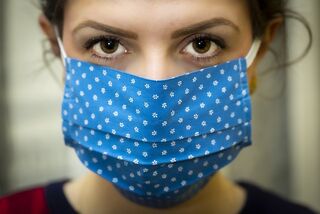Reading a Person Who’s Wearing a Mask
Much can be learned, even if the lower face is obscured.
by Marty Nemko Ph.D.
Knowing how to read people is key to effective communication: from business discussion to romantic exploration, to parenting. And we’ve long known that we can learn a lot about people and what they're feeling by observing their face, even down to microexpressions, those flashes of authenticity before the person covers up.
But covering up has been made easy because we’re all masking up amid COVID. How might we still learn a lot from watching a person?
First, a caveat: As body language expert and fellow Psychology Today blogger, Joe Navarro, warns, all body language “tells” are far from perfect. They’re merely tools for developing hypotheses about what’s going on with a person,
Type of mask. I’m not talking about the obvious, like the many people here in the Bay Area who wear masks emblazoned with a political battle cry. Slightly subtler, is the person’s mask a fashion statement, even down to matching his or her outfit?
Forehead. We wear our personality on our face, especially as we get older when our wrinkles reflect our default demeanor. For example, upbeat people tend to develop smile lines around the eyes (and unmasked, the corners of their mouth curled upward in a semi-smile.) Worriers and angry people tend to have a furrowed brow and when unwmasked, the corners of their mouth are downward.
Eyes. Most people tend to avert their eyes lest they be seen as unwantedly friendly or even flirtatious. If someone holds eye contact with you for more than a split second, ask yourself, “Given the context, what is the most likely reason: Fear of you, platonic friendliness, or, yes, flirtation?
Of course, mask or not, unless the person is wearing a hazmat suit, the person’s appearance other than their face offers more clues:
Clothes. As with style of mask, the person’s choice of clothes can signal their personality: neat or sloppy, upscale or down, sexy or not, fashion-forward, timeless, or chosen for blending in, invisibility, helping them remain unseen? Here in the Bay Area, many people wear loose, unisex clothes in natural fibers in black, gray, or other dull color. Even if the person’s tee shirt doesn’t trumpet a political slogan, that "uniform" may signal that they’re a political “progressive.” Choice of hair style also can signal everything from politics to sexual orientation, to desire to attract attention.
Posture. People are less aware of their posture than of their facial expression, so posture can provide more authentic clues to what’s going on with the person.
Of course, there are many exceptions, but a head tilted upward suggests confidence or at least the desire to appear confident. A head tilted downward could reflect introspection, shyness, or humility.
How about their shoulders? Shoulders back suggests confidence—or that s/he was taught good posture. Hunching forward could suggest shyness, uncomfortability with their body, lack of confidence, or humility.
Gait. A speedy gait suggests health, purposefulness, intensity, and/or a preference for quickness, not just in gait, but perhaps in conversations that are crisp and to the point rather than leisurely and expansive.
The takeaway
Again, these clues are far from perfect, merely creators of hypotheses, but even in the time of COVID masking, much can be learned if we just look.
I read this aloud on YouTube.